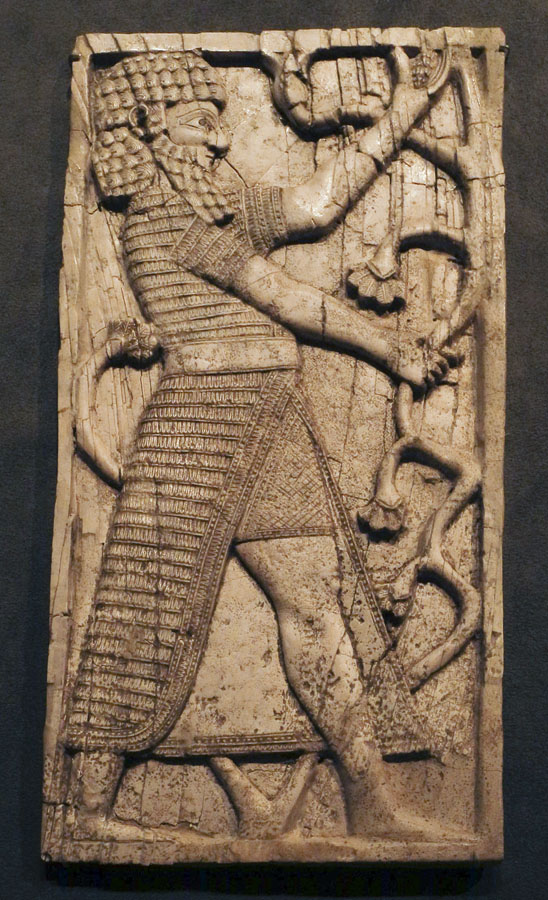Plaque with lioness attacking a youth, Nimrud, 9th-8th century B.C.; ivory, gold, semiprecious stones, and vitreous material. Image courtesy NY Times
Wandering the galleries at the Metropolitan Museum of Art––from the Near East to the Far East, to Africa, and the Americas, and Europe; from millennia B.C. to the current day––I often marvel at the human desire for beauty. We seem to need it, along with a need to picture, to represent the world around us. The objects that remain, that are exhibited in museums, are of course the most beautiful and are often for the elites of a culture, but aren't we lucky to have them! The other characteristic of human culture that the Met at times emphasizes in special exhibitions is our wandering nature; whether to conquer or to trade or out of curiosity or need, we move about the globe. In the current exhibition, Assyria to Iberia at the Dawn of the Classical Age, we see works from the Near Eastern empires to those of the Mediterranean, and see influences flow back and forth.
I have to admit, though, that I am less interested in the complex histories of the works––some of which you can see in an excellent slide show at the NY Times––than their aesthetic qualities. The remarkable plaque above was my favorite piece in the show, small though it is. In it, the lithe bodies of man and animal are locked in an embrace; rather than a struggle we see a kiss and an ecstatic surrender. The elegantly patterned surroundings emphasize the beauty of the moment, rather than its horror.
Chair back panel with striding man, Nimrud, 9th-8th century B.C.; ivory.
There were other beautifully carved small ivory pieces on view. Photographs were not allowed, the Met's website has very few images, so I "stole" a few photographs when I could. I love relief carving. maybe because it's between sculpture and painting; a subtle three dimensionality doesn't overwhelm the elegant composition of flowing line and the sensitive depiction of the forms of plant, animal, and human.
Relief showing a lion hunt, with king pouring a libation over the dead lions, Nineveh,
ca. 645-640 B.C.; gypsum alabaster.
Reliefs showing the battle of Til Tuba, Nineveh, 660-650 B.C.; limestone.
Bodies upon bodies: the Assyrian kingdom was a violent and bloodthirsty one, whether killing lions in a ritual hunt or killing men in battle. But....the artists of the kingdom made from these events powerful and moving sculpture. There is very careful and detailed observation, especially in the picturing of animals. The men are stiff, their emotions contained, but the lions have both pathos and grandeur. I remember being moved to tears by the panels of the Assyrian lion hunt when I first saw them at the British Museum many years ago.
Cauldron with lion attachments, Caere, 675-650 B.C.; bronze.
Lions appear again, in more stylized form, on a large cauldron. This is from ancient Etruria, near Rome, and was influenced by designs from the Near East. To me it looks like a magical, ceremonial object, almost frightening in its decorations of open-mouthed, fierce-toothed lions. The curved forms of the attachments echo the bulbous form of the container.
Cosmetic container, Etruria, 700-650 B.C.; Tridacna squamosa shell.
Lastly, objects I found utterly charming: cosmetic containers made from large shells. In the several on view, a woman's head was carved into the top of the shell, the part called an umbo. The shell itself, with decorative carvings, became the flowing lines of a dancing cape. There is such pleasure for me in these works and others in this exhibition, seeing imagination and artistry powerfully present centuries after their making.







That last piece is fantastic!
ReplyDeleteI'm glad you like it, JBS; I thought the shell pieces were terrific.
Delete